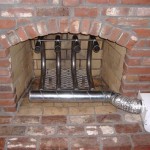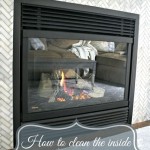```html
Best Way to Mount a TV Above a Fireplace
Mounting a television above a fireplace is a popular design choice for many homeowners. It can consolidate entertainment space and create a focal point in a living room or family room. However, this installation requires careful planning and execution to ensure both the longevity of the television and the structural integrity of the wall. Several factors must be considered, including heat exposure, viewing angles, cable management, and the structural support available. Failing to address these aspects adequately can lead to damage to the television, an uncomfortable viewing experience, or even structural issues with the wall itself.
This article explores the optimal methods for mounting a television above a fireplace, detailing the necessary precautions, equipment, and techniques to achieve a safe and aesthetically pleasing installation. It encompasses considerations for different types of fireplaces, wall structures, and television models, offering a comprehensive guide for homeowners and installers.
Determining Feasibility and Addressing Heat Concerns
Before proceeding with any installation, a critical assessment of the fireplace's heat output is paramount. Excessive heat can significantly reduce the lifespan of a television, potentially damaging its internal components and voiding the warranty. There are several types of fireplaces, each presenting different heat-related challenges. Gas fireplaces tend to produce more consistent and predictable heat, while wood-burning fireplaces can generate intense bursts of heat and fluctuating temperatures. Electric fireplaces, conversely, generally produce less heat and often allow for more flexibility in television placement.
To gauge the heat exposure, operate the fireplace at its highest setting for a prolonged period and monitor the temperature of the wall above the mantel. A thermometer with a remote probe can be particularly useful for this purpose. Manufacturers typically specify an acceptable operating temperature range for their televisions. If the wall above the fireplace exceeds this range, mitigation strategies are essential. These strategies may include installing a mantel that extends further outward to deflect heat, employing a heat shield to protect the television, or opting for a full-motion mount that allows the television to be pulled away from the wall during fireplace use. Furthermore, ensuring adequate ventilation around the television by leaving sufficient space between the back of the television and the wall can help dissipate heat.
Consider the type of fireplace insert, if any. Some inserts are designed to radiate heat primarily forward, reducing the amount of heat that rises directly above. Understanding the architecture of the fireplace and its ventilation system is critical to determine the potential impact on the television.
Choosing the Right Mounting Hardware and Ensuring Structural Support
Selecting the appropriate mounting hardware is critical for a secure and stable installation. The weight and size of the television will dictate the type of mount required. A fixed mount provides a low-profile appearance and is suitable for situations where the viewing angle is ideal and adjustments are not necessary. A tilting mount allows for vertical adjustments to improve the viewing angle, particularly useful when the television is mounted higher on the wall. A full-motion mount offers the greatest flexibility, allowing the television to be swivelled or extended for optimal viewing from various positions in the room. Each type of mount has weight capacity ratings that must be carefully considered to ensure they exceed the weight of the television. It’s advisable to choose a mount rated for significantly more than the television’s weight to provide a safety margin.
Before mounting, locate the wall studs. Wall studs are the vertical wooden beams that provide structural support within the wall. Using a stud finder is the most effective way to locate these studs. The mount should be securely attached to at least one, and preferably two, wall studs. If the stud placement does not align with the mounting holes on the television mount, a mounting board can be installed across the studs to provide a solid surface for attaching the mount. The mounting board should be made of sturdy material such as plywood and securely fastened to the studs using appropriate screws. For brick or stone fireplaces, specialized masonry anchors are required. These anchors are designed to expand within the brick or stone, providing a secure hold. It is crucial to use anchors rated for the weight of the television and the mount. If unsure about the suitable anchoring method, consult with a professional installer.
Inspect the wall for any pre-existing wiring or plumbing before drilling. Damaging these utilities can lead to costly repairs and potential safety hazards. Consider hiring a qualified electrician to inspect the wall cavity and ensure no hidden obstacles exist.
Managing Cables and Optimizing Viewing Angle
Effective cable management is essential for a clean and aesthetically pleasing installation. Running cables behind the wall conceals them from view, creating a more streamlined appearance. This often involves cutting holes in the wall for the cables to pass through. Use a low-voltage mounting bracket to protect the cables and prevent them from rubbing against the drywall. It’s recommended to use in-wall rated cables, which are designed to be fire-resistant and meet building code requirements. Consider using cable ties or Velcro straps to bundle the cables together, preventing them from tangling or becoming damaged.
Plan the cable routing carefully to ensure all necessary connections can be made easily. Consider including spare cables for future expansion or changes in equipment. Labeling the cables can also simplify troubleshooting and cable management in the future. Avoid running power cables alongside low-voltage cables, as this can cause interference. Use separate pathways for power and signal cables to maintain signal integrity.
The viewing angle is another crucial factor to consider. Mounting a television too high can result in neck strain and an uncomfortable viewing experience. Ideally, the center of the television screen should be at or slightly below eye level when seated. However, above-fireplace installations often necessitate mounting the television higher than this ideal position. Using a tilting mount can help compensate for the increased height by angling the television downward. Before finalizing the installation, simulate the viewing experience by temporarily holding the television in place and assessing the comfort level from various seating positions. This will help determine the optimal tilt angle and ensure a comfortable viewing experience.
Furthermore, consider the distance from the seating area to the television. A larger television may be necessary for comfortable viewing from a greater distance. Use online calculators or consult with a home theater professional to determine the ideal screen size based on the viewing distance.
Properly hiding the power cable can be achieved with several methods. One option is to use a power relocation kit, which allows you to safely move the outlet behind the television. This eliminates the need for a visible power cord running down the wall. Another option is to use a cable concealer, which is a plastic channel that runs along the wall and hides the cable. These concealers are available in various colors and sizes to match your décor.
When dealing with different wall types, such as drywall, plaster, or brick, each requires a specific approach. Drywall is the simplest to work with, requiring only a stud finder and appropriate screws. Plaster walls can be more challenging, as they tend to crumble easily. Use specialized anchors designed for plaster walls to ensure a secure hold. Brick walls require the use of a hammer drill and masonry anchors. Always wear safety glasses when drilling into brick or stone to protect your eyes from debris.
Consider the aesthetic impact of the installation. Choose a mount that complements the style of your fireplace and the surrounding décor. Conceal any exposed cables or wires to create a clean and uncluttered look. Consider adding decorative elements, such as shelves or artwork, to balance the visual weight of the television and the fireplace.
Regularly inspect the mount and connections to ensure they remain secure. Over time, screws can loosen or anchors can weaken. Periodically check the mount and tighten any loose screws or replace any worn anchors. This will help prevent the television from falling and ensure its continued safety.
Remember that safety should always be the top priority. If you are not comfortable performing the installation yourself, it is best to hire a qualified professional. A professional installer has the experience and expertise to ensure a safe and reliable installation. They can also help you choose the right equipment and address any potential challenges.
```
Can I Mount My Tv Above The Fireplace

Can I Mount My Tv Above The Fireplace

Putting A Tv Above The Fireplace May Not Be Such Bad Idea After All

How To Mount A Tv Over Fireplace Vertical Chimney Care

3 Alternatives To Mounting Your Television Above The Fireplace Avs
Can I Mount A Tv Over My Fireplace Heatilator

The Ultimate Guide To Mounting Your Tv Over Fireplace 4 Easy Steps Patriot Chimney

Is It Safe To Mount Your Tv Above The Fireplace Chimney And Wildlife

Mounting A Tv Above The Fireplace Mantelmount

ᑕ❶ᑐ What To Consider Before Mounting A Tv Above Fireplace
Related Posts








